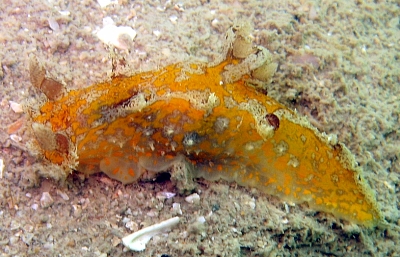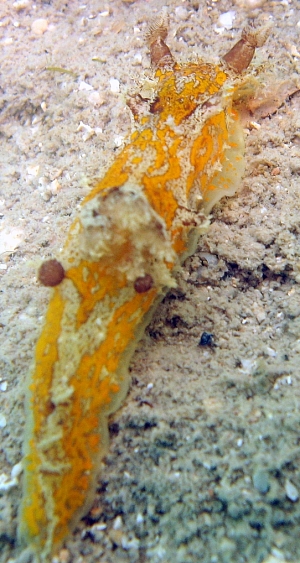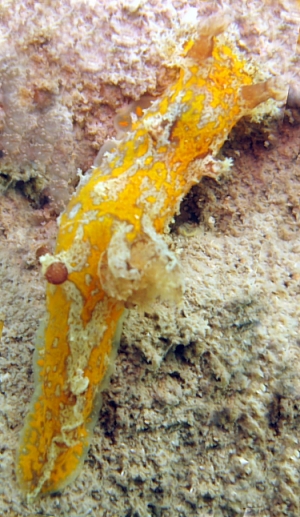Plocamopherus ceylonicus from Singapore
February 27, 2007
From: Toh Chay Hoon

Dear Dr Bill,
I came across this nudibranch during a dive at Singapore Pulau Hantu today.
Here's a few photos attached. Could you kindly help with the ID?
Locality: Pulau Hantu, 5 m, Singapore, South China Sea, 25 February 2007, Coral Reefs, Substrate, Silts. Length: 40 mm. Photographer: Toh Chay Hoon.
Thanks & Regards,
Toh Chay Hoon
sonnenflower@gmail.com


Dear Chay Hoon,
I am pretty sure this is an orange form of Plocamopherus ceylonicus. The background colour in this species seems to be quite variable, ranging from dark brown to translucent whitish and sometimes, as in your animal, the orange-yellow appears not as the normal small spots, but as large patches. There are two fairly consistent colour characteristics of this species and they are the orange spots on the sides of the body and the foot, and the whitish band along the edge of the mantle which behind the gills joins with the equivalent band on the other side and runs down the dorsal midline of the posterior 'tail'. I am pretty sure the animal identified as Plocamopherus cf imperialis by Valles & Gosliner (2006) is a dark brown form of P. ceylonicus. I also suspect that their new species P. pecoso and P. lemur are colour forms as well. They all have the white Y shape behind the gills.
One other interesting feature of your animal is the large brown sphere on each side just behind the gills. As I have mentioned elsewhere in the Forum P. ceylonicus and P. imperialis can produce flashes of light, and these spheres are a major site of this bioluminescence, although flashes of light can occur elsewhere on the sides of the body. Lucas Cervera also reports it in Plocamopherus maderae [message #1286]. It is a fascinating topic but unofrtunately we know little about how it occurs in these nudibranchs. When I saw the catchy title of Valles & Gosliner's paper I thought they were 'shedding light' on this bioluminescence but sadly not. If you look at other photos of P. ceylonicus on the Forum you will find that there can be between one and four of these spheres. I suspect they can be damaged, or nibbled off by fish, but since they are often if different sizes, I also suspect that they can be regrown.
-
Valles, Y. & Gosliner, T. (2006). Shedding Light onto the Genera (Mollusca: Nudibranchia) Kaloplocamus and Plocamopherus with Description of New Species Belonging to These Unique Bioluminescent Dorids. The Veliger 48(3): 178-205.
Best wishes,
Bill Rudman
Related messages
-
Re: Plocamopherus ceylonicus from Ratnagiri, India
From: Vishal Bhave, November 4, 2009 -
Plocamopherus ceylonicus from Ratnagiri, India
From: Vishal Bhave, October 26, 2009 -
Plocamopherus ceylonicus ? from Ratnagiri, India
From: Vishal Bhave, June 1, 2009 -
Re: Cowry? from Townsville, Queensland
From: Melanie Wood, August 29, 2007 -
Plocamopherus ceylonicus from Western Australia
From: Bruce Potter, April 27, 2007 -
Plocamopherus ceylonicus from Western Australia
From: Brent Murdoch, February 27, 2007 -
Re: Plocamopherus tilesii from West Australia
From: Samantha Haebich, November 6, 2006 -
Re: Plocamopherus tilesii from Port Stephens, NSW
From: Samantha Haebich, October 31, 2006 -
Plocamopherus maculatus from Philippines
From: Jeff Rosenfeld, September 12, 2005 -
Plocamopherus ceylonicus from northern NSW
From: Denis Riek, July 23, 2004 -
Hong Kong Plocamopherus ceylonicus
From: W.B. Rudman & B.W. Darvell, March 11, 2002 -
Plocamopherus ceylonicus from the Marshalls
From: Scott Johnson, March 29, 2000 -
Plocamopherus ceylonicus - early paintings
From: Bill Rudman, March 29, 2000 -
Plocamopherus ceylonicus from Sulawesi
From: Lindsay Warren, March 28, 2000
